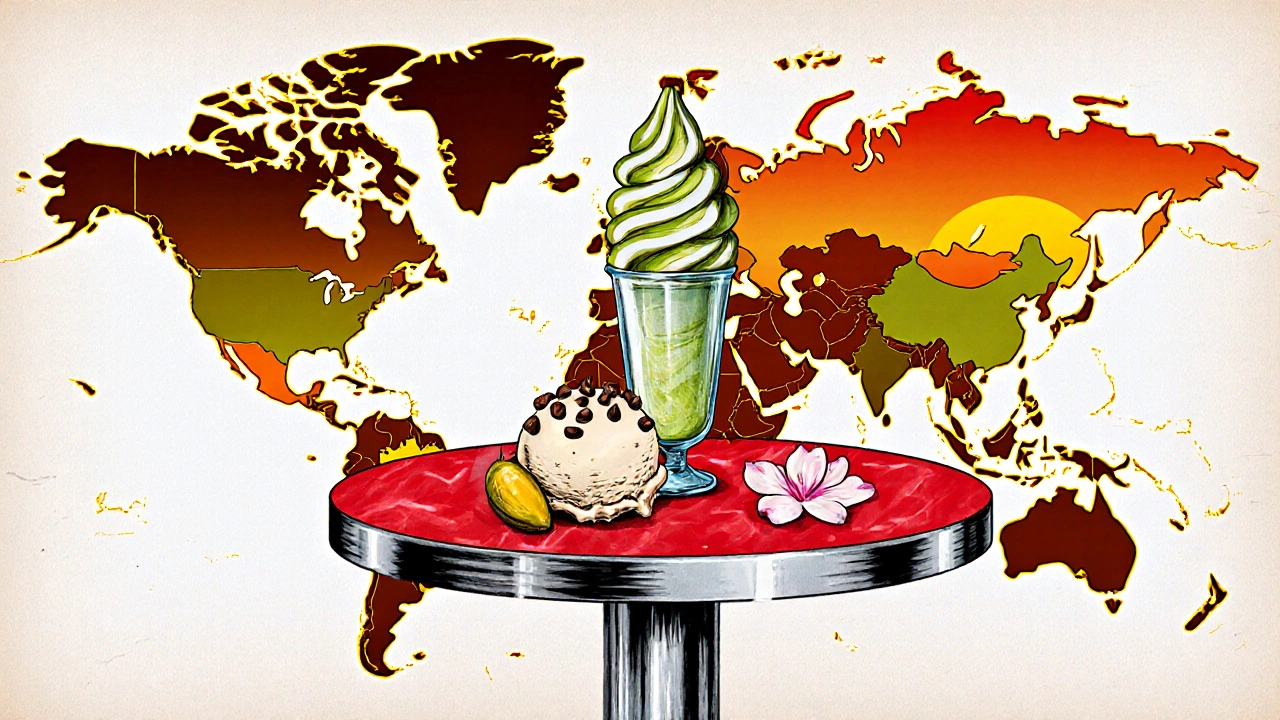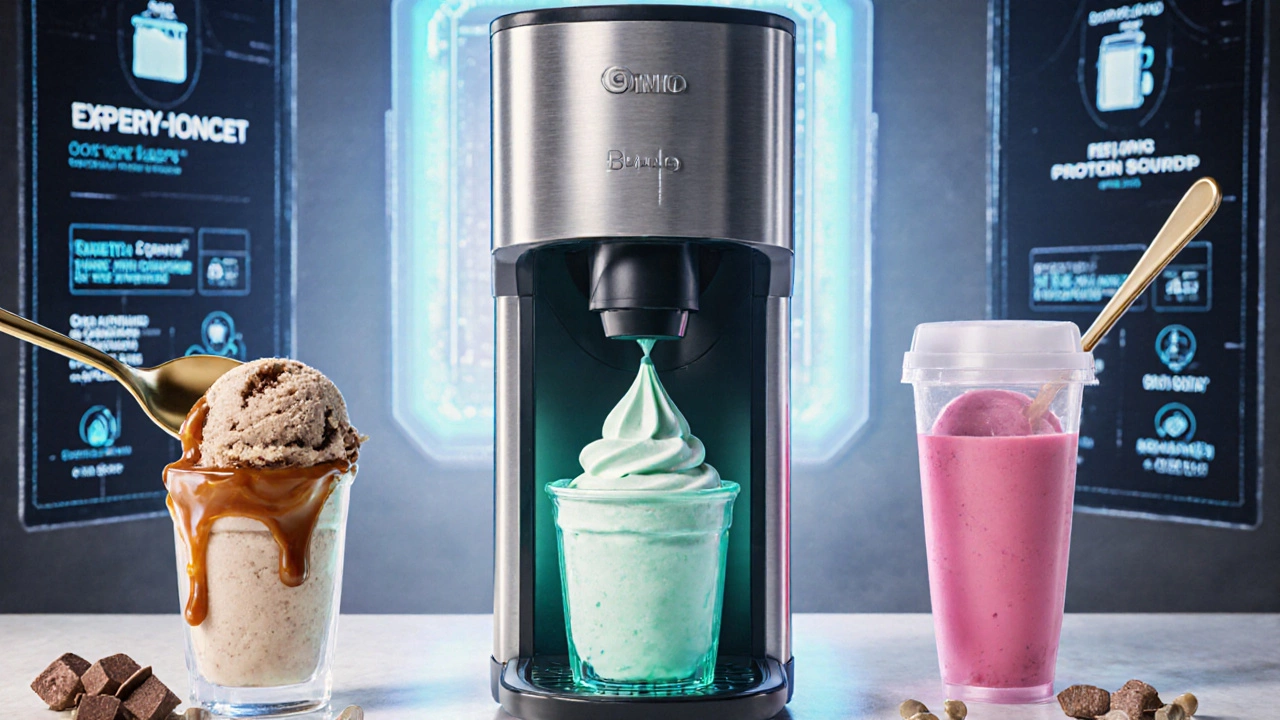Dessert Sales Comparison Calculator
Global Dessert Revenue Calculator
Calculate revenue based on servings sold for the top dessert categories. See how ice cream outperforms other treats by millions of servings and billions of dollars.
Revenue Calculation
Why Ice Cream Dominates
Ice cream generates $2.60 in revenue per billion servings compared to $2.75 for chocolate cake. Despite having a higher revenue per unit, ice cream's massive volume (30 billion servings) gives it a 3.5x revenue advantage over the next dessert. Its year-round demand and marketing power make it the undisputed market leader.
Key Takeaways
- Ice cream tops the global dessert market, generating over $78 billion in 2024.
- It outsells traditional baked goods because it’s easy to serve, has year‑round demand, and benefits from strong brand marketing.
- The top five desserts by revenue are ice cream, chocolate cake, apple pie, gelato, and baklava.
- Emerging trends - plant‑based versions and premium‑flavor launches - are reshaping the ice‑cream segment.
- If you’re planning a new recipe or menu, focusing on ice‑cream‑friendly flavors can drive higher sales.
When you ask "What is the most sold dessert?" you’re really looking for the sweet treat that rakes in the biggest slice of the global pie - in dollars, units, and consumer mindshare. The short answer is ice cream. It beats everything from chocolate cake to macarons when you line up worldwide sales data from 2023‑2024. Below we break down why ice cream wears the crown, how the numbers are calculated, and what that means for anyone who cooks, sells, or simply loves desserts.
How Dessert Sales Are Measured
Before we crown a winner, it helps to know how the industry tallies sales. Two main metrics dominate:
- Revenue: Total money earned by manufacturers, retailers, and food‑service operators. This figure captures premium products, holiday limited‑editions, and bulk sales to restaurants.
- Units sold: The number of individual servings or packages moved. For drinks and frozen desserts, a "unit" often means a single‑serve container or a scoop‑equivalent.
Data comes from market‑research firms like Statista, which aggregates company reports, retail scanner data, and customs records. Euromonitor International adds macro‑economic context, adjusting for exchange‑rate shifts and inflation.
Both revenue and unit counts are cross‑checked with government trade statistics - for example, the World Bank publishes export‑import flows that help validate local market reports.
Ice Cream Leads the Global Market
According to Statista’s 2024 Global Ice Cream Market report, the sector hit US$78 billion in revenue, a 12 % increase over the previous year. That translates to roughly 2.5 billion servings per month, or 30 billion servings a year.
Why does ice cream dominate?
- Year‑round appeal: Even in colder climates, consumers still purchase ice cream for indoor consumption and as a dessert after hot meals.
- High margin products: Premium brands command 30‑40 % gross margins because of perceived indulgence.
- Strong distribution: Ice cream is stocked in supermarkets, convenience stores, gas stations, and food‑service outlets, ensuring massive shelf presence.
- Marketing muscle: Global giants like Unilever (Ben & Jerry’s, Magnum) spend billions on advertising, sponsorships, and seasonal campaigns.
These forces combine to push ice cream ahead of baked desserts, which face higher production costs and shorter shelf lives.

Regional Favorites Within Ice Cream
While ice cream is the world champion, its flavors and formats vary by market:
- United States: Classic vanilla, chocolate chip, and cookie‑dough dominate. Retail sales are split roughly 45 % grocery, 30 % food‑service, 25 % specialty shops.
- Europe: Premium “gelato”‑style products, often dairy‑rich and low‑fat, command a higher price point. Countries like Italy and France favor pistachio and hazelnut.
- Asia‑Pacific: Green‑tea, red‑bean, and mango flavors lead, reflecting local taste palettes. In China, ice‑cream‑based desserts such as “snow jelly” are exploding.
These regional nuances keep the overall market vibrant and ensure continuous product innovation.
Top 5 Desserts by Global Sales (2024)
| Dessert | Approx. Global Revenue (US$ bn) | Units Sold (Billion Servings) | Key Markets |
|---|---|---|---|
| Ice Cream | 78 | 30 | US, EU, China |
| Chocolate Cake | 22 | 8 | US, UK, Brazil |
| Apple Pie | 15 | 5 | US, Canada, Australia |
| Gelato | 13 | 4 | Italy, Germany, Japan |
| Baklava | 9 | 3 | Turkey, Middle East, USA |
The table shows that ice cream’s revenue is more than three times that of the next best‑selling dessert, chocolate cake. Even when you count units, its serving numbers dwarf the competition.
Why Ice Cream Outpaces Baked Desserts
Several practical reasons explain the gap:
- Cold chain advantage: Freezing extends shelf life, reducing waste for retailers.
- Portion flexibility: From single‑scoop cups to family‑size tubs, producers can target any price point.
- Impulse buying: Ice‑cream aisles are positioned near checkout, encouraging spur‑of‑the‑moment purchases.
- Innovation speed: New flavors can be rolled out in weeks, while a new cake recipe may require new baking equipment or longer shelf‑life testing.
These factors give ice cream a distribution and marketing edge that baked goods simply can’t match.

Emerging Trends Shaping the Ice‑Cream Segment
Even a market leader has to evolve. Here are three trends gaining traction in 2025:
- Plant‑based alternatives: Coconut, oat, and pea‑protein bases now account for 12 % of global ice‑cream sales, driven by vegan consumers and lactose‑intolerant shoppers.
- Premium “experience” flavors: Brands are launching limited‑edition collaborations with chefs (e.g., truffle‑salt caramel) that command up to 60 % higher price points.
- Functional add‑ins: Protein‑enriched, probiotic‑infused, and low‑sugar variants address health‑conscious demand without sacrificing indulgence.
If you plan a new recipe or product line, tapping into one of these niches can help you capture a slice of the massive pie.
How to Use This Insight for Your Own Dessert Business
Whether you’re a home baker, a café owner, or a food‑service director, the data suggests a clear strategy:
- Prioritize ice‑cream‑friendly flavors: Classic vanilla, chocolate, fruit‑based, and trending plant‑based bases sell consistently.
- Offer multiple formats: Single‑serve cups for on‑the‑go customers, plus family‑size tubs for gatherings.
- Leverage seasonal marketing: Summer promotions, holiday‑themed packaging, and limited‑edition flavors keep demand high year‑round.
- Test premium add‑ins: Small‑batch batches of “artisan” flavors can command higher margins without huge volume risk.
By aligning your menu with the top‑selling dessert category, you improve the odds of higher turnover and repeat business.
Frequently Asked Questions
Which dessert generates the most revenue worldwide?
Ice cream leads the global market with about US$78 billion in sales for 2024, far ahead of baked desserts like chocolate cake or apple pie.
Is ice cream also the most sold by unit count?
Yes. Roughly 30 billion servings were sold in 2024, which outstrips the next best‑selling dessert (chocolate cake) by more than three times.
What are the fastest‑growing dessert categories?
Plant‑based ice cream, functional‑add‑in varieties (protein, probiotics), and premium collaborative flavors are growing at double‑digit rates.
How reliable are the sales figures?
Data comes from Statista, Euromonitor, and national trade reports, which cross‑validate each other using retailer scanner data and customs records.
Can a small bakery compete in the ice‑cream market?
Yes, by focusing on niche flavors, local ingredients, and limited‑edition batches, small producers can command premium prices and attract loyal customers.
Bottom line: if you want to bake, sell, or simply understand the dessert world, ice cream is the undisputed leader. Its massive revenue, versatile formats, and constant innovation make it the go‑to sweet for both consumers and businesses worldwide.

